Drp1 splice variants regulate ovarian cancer mitochondrial dynamics and tumor progression
- PMID: 39191946
- PMCID: PMC11467262
- DOI: 10.1038/s44319-024-00232-4
Drp1 splice variants regulate ovarian cancer mitochondrial dynamics and tumor progression
Abstract
Aberrant mitochondrial fission/fusion dynamics are frequently associated with pathologies, including cancer. We show that alternative splice variants of the fission protein Drp1 (DNM1L) contribute to the complexity of mitochondrial fission/fusion regulation in tumor cells. High tumor expression of the Drp1 alternative splice variant lacking exon 16 relative to other transcripts is associated with poor outcome in ovarian cancer patients. Lack of exon 16 results in Drp1 localization to microtubules and decreased association with mitochondrial fission sites, culminating in fused mitochondrial networks, enhanced respiration, changes in metabolism, and enhanced pro-tumorigenic phenotypes in vitro and in vivo. These effects are inhibited by siRNAs designed to specifically target the endogenously expressed transcript lacking exon 16. Moreover, lack of exon 16 abrogates mitochondrial fission in response to pro-apoptotic stimuli and leads to decreased sensitivity to chemotherapeutics. These data emphasize the pathophysiological importance of Drp1 alternative splicing, highlight the divergent functions and consequences of changing the relative expression of Drp1 splice variants in tumor cells, and strongly warrant consideration of alternative splicing in future studies focused on Drp1.
Keywords: DNM1L; Alternative Splice Variants; Drp1; Mitochondrial Fission; Ovarian Cancer.
© 2024. The Author(s).
Conflict of interest statement
The authors declare no competing interests.
Figures

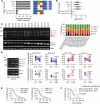
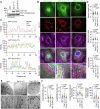

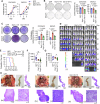

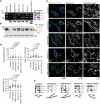


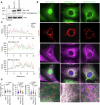
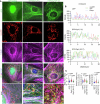
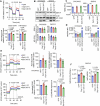
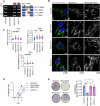
Update of
-
Alternative splice variants of the mitochondrial fission protein DNM1L/Drp1 regulate mitochondrial dynamics and tumor progression in ovarian cancer.bioRxiv [Preprint]. 2024 Jan 24:2023.09.20.558501. doi: 10.1101/2023.09.20.558501. bioRxiv. 2024. Update in: EMBO Rep. 2024 Oct;25(10):4281-4310. doi: 10.1038/s44319-024-00232-4. PMID: 37790404 Free PMC article. Updated. Preprint.
Similar articles
-
Alternative splice variants of the mitochondrial fission protein DNM1L/Drp1 regulate mitochondrial dynamics and tumor progression in ovarian cancer.bioRxiv [Preprint]. 2024 Jan 24:2023.09.20.558501. doi: 10.1101/2023.09.20.558501. bioRxiv. 2024. Update in: EMBO Rep. 2024 Oct;25(10):4281-4310. doi: 10.1038/s44319-024-00232-4. PMID: 37790404 Free PMC article. Updated. Preprint.
-
Cyclin-dependent kinases regulate splice-specific targeting of dynamin-related protein 1 to microtubules.J Cell Biol. 2013 Jun 24;201(7):1037-51. doi: 10.1083/jcb.201210045. J Cell Biol. 2013. PMID: 23798729 Free PMC article.
-
Dynamin-related protein 1-mediated mitochondrial fission contributes to IR-783-induced apoptosis in human breast cancer cells.J Cell Mol Med. 2018 Sep;22(9):4474-4485. doi: 10.1111/jcmm.13749. Epub 2018 Jul 11. J Cell Mol Med. 2018. PMID: 29993201 Free PMC article.
-
The role of Drp1 adaptor proteins MiD49 and MiD51 in mitochondrial fission: implications for human disease.Clin Sci (Lond). 2016 Nov 1;130(21):1861-74. doi: 10.1042/CS20160030. Clin Sci (Lond). 2016. PMID: 27660309 Review.
-
[Mechanism of mitochondrial fission - structure and function of Drp1 protein].Postepy Biochem. 2016;62(2):127-137. Postepy Biochem. 2016. PMID: 28132464 Review. Polish.
Cited by
-
Unlocking the mitochondrial functional code: unraveling the pathogenesis of ovarian cancer and innovative targets to inhibit malignant behavior.J Transl Med. 2025 Jul 24;23(1):819. doi: 10.1186/s12967-025-06840-5. J Transl Med. 2025. PMID: 40707948 Free PMC article. Review.
-
Alternative splicing in ovarian cancer.Cell Commun Signal. 2024 Oct 18;22(1):507. doi: 10.1186/s12964-024-01880-8. Cell Commun Signal. 2024. PMID: 39425166 Free PMC article. Review.
-
Deciphering Mitochondria: Unveiling Their Roles in Mechanosensing and Mechanotransduction.Research (Wash D C). 2025 Aug 8;8:0816. doi: 10.34133/research.0816. eCollection 2025. Research (Wash D C). 2025. PMID: 40785969 Free PMC article. Review.
-
Mitochondrial fission - changing perspectives for future progress.J Cell Sci. 2025 May 1;138(9):jcs263640. doi: 10.1242/jcs.263640. Epub 2025 Mar 19. J Cell Sci. 2025. PMID: 40104946 Review.
-
Integrated multi-omics analysis and experimental investigation of mitochondrial dynamics-related genes: molecular subtypes, immune landscape, and prognostic implications in lung adenocarcinoma.Front Immunol. 2025 May 29;16:1585505. doi: 10.3389/fimmu.2025.1585505. eCollection 2025. Front Immunol. 2025. PMID: 40510359 Free PMC article.
References
-
- Alan L, Scorrano L (2022) Shaping fuel utilization by mitochondria. Curr Biol 32:R618–R623 - PubMed
-
- Archer SL (2013) Mitochondrial dynamics-mitochondrial fission and fusion in human diseases. N Engl J Med 369:2236–2251 - PubMed
-
- Arnoult D, Rismanchi N, Grodet A, Roberts RG, Seeburg DP, Estaquier J, Sheng M, Blackstone C (2005) Bax/Bak-dependent release of DDP/TIMM8a promotes Drp1-mediated mitochondrial fission and mitoptosis during programmed cell death. Curr Biol 15:2112–2118 - PubMed
-
- Banerjee R, Mukherjee A, Nagotu S (2022) Mitochondrial dynamics and its impact on human health and diseases: inside the DRP1 blackbox. J Mol Med 100:1–21 - PubMed
MeSH terms
Substances
Grants and funding
- R01CA242021/HHS | NIH | National Cancer Institute (NCI)
- S10RR025488/HHS | NIH | National Center for Research Resources (NCRR)
- 2T32HL110849-11A1/HHS | NIH | National Heart, Lung, and Blood Institute (NHLBI)
- R01 CA230628/CA/NCI NIH HHS/United States
- P50 CA272218/CA/NCI NIH HHS/United States
- P30 CA047904/CA/NCI NIH HHS/United States
- P50CA272218/HHS | NIH | National Cancer Institute (NCI)
- W81XWH-22-10252/U.S. Department of Defense (DOD)
- S10 OD023402/OD/NIH HHS/United States
- S10RR019003/HHS | NIH | National Center for Research Resources (NCRR)
- S10OD023402/HHS | NIH | NIH Office of the Director (OD)
- R01 CA256911/CA/NCI NIH HHS/United States
- W81XWH-16-1-0117/U.S. Department of Defense (DOD)
- P30CA047904/HHS | NIH | National Cancer Institute (NCI)
- R35HL150778/HHS | NIH | National Heart, Lung, and Blood Institute (NHLBI)
- R01 CA233844/CA/NCI NIH HHS/United States
- R35 HL150778/HL/NHLBI NIH HHS/United States
- R01CA230628/HHS | NIH | National Cancer Institute (NCI)
- S10RR016236/HHS | NIH | National Center for Research Resources (NCRR)
- S10 RR019003/RR/NCRR NIH HHS/United States
- R01 CA242021/CA/NCI NIH HHS/United States
- T32 HL110849/HL/NHLBI NIH HHS/United States
- S10 RR025488/RR/NCRR NIH HHS/United States
LinkOut - more resources
Full Text Sources
Medical
Miscellaneous

